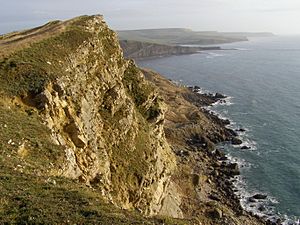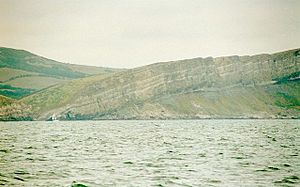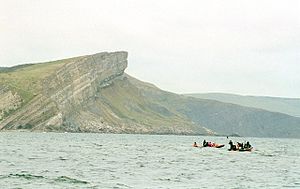Gad Cliff facts for kids
Gad Cliff is a tall cliff that faces south, located on the southern coast of the Isle of Purbeck in Dorset, England. It's right next to Worbarrow Tout and Pondfield Cove. Behind the cliff is an area called Gold Down, which is part of the Lulworth Ranges. These ranges are military training areas.
Where is Gad Cliff?
Gad Cliff is about 1 kilometre (0.62 mi) south of Tyneham, which is a ghost village. It is also about six kilometres south of Wareham. The cliff is about 2 kilometres (1.2 mi) west of Kimmeridge Bay and about 14 kilometres (8.7 mi) west of Swanage.
You can only visit Gad Cliff when the Lulworth Ranges are open to the public. You can get there by walking uphill from the car park near the ghost village of Tyneham. Another way is to walk along the coast from Kimmeridge Bay using the South West Coast Path.
The highest part of Gad Cliff is about 134 metres (440 ft) above sea level. Gold Down is the most western part of this cliff. There's a large rock called Wagon Rock. It fell from the top of Gad Cliff onto the beach below.
How the Rocks Formed

The rocks around the Isle of Purbeck are very interesting and complex. You can see this clearly along the coast near Gad Cliff. The layers of rock are bent and twisted in extreme ways. This shows how the rocks were folded a long time ago.
These folds, called the Purbeck Monocline, happened about 30 million years ago. They were caused by huge forces when the African and European continents slowly pushed against each other. During this time, the rock layers were twisted. This is why younger rocks are found at the back of Worbarrow Bay. At Gad Cliff, the rock layers tilt inland at an angle of 25 to 35 degrees. At the very top of the cliffs, you can clearly see that the rocks have been folded into a giant 'S' shape. This 'S' shape is a result of the powerful earth movements.
The very top of Gad Cliff is made of Purbeck Beds, which are 147 million years old. Below that are Portland limestones, which are 150 million years old. These layers sit on top of Portland Sands. Underneath all of these is the Kimmeridge Clay, which is about 155 million years old.
Because the hard limestone and sandstone layers sit on top of unstable clay, the cliff face can sometimes have landslides. At the far western end of Gad Cliff is Worbarrow Tout. This forms the southern edge of Worbarrow Bay, which is carved into softer clays and sands.




